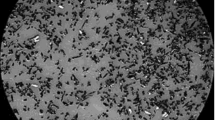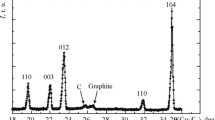Abstract
The oxidation of hot-pressed boron carbide under isothermal conditions and under conditions of programmed heating up to 1500°C was investigated. Oxidized samples were studied by secondary-ion mass spectrometry, X-ray photoelectron spectroscopy, scanning electron microscopy, energy-dispersive X-ray microanalysis, X-ray diffraction, and other methods. It has been demonstrated that oxidation starts above 600°C and results in the formation of a thin transparent B2O3 film that is cracked after cooling. Up to 1200°C, the oxidation process is limited by the diffusion of reagents through the oxide layer; at higher temperatures, it is determined by the rate of chemical reaction of carbide with oxygen in the air. During boron carbide oxidation the etching of grain boundaries occurs, it results in strength degradation at higher temperatures.
Similar content being viewed by others
References
G. V. Samsonov and I. M. Vinitsky,Refractory Compounds (Metallurgiya, Moscow, 1976).
R. F. Vojtovich,Oxidation of Carbides and Nitrides (Naukova Dumka, Kiev, 1981).
G. A. Meerson and G. V. Samsonov,Zavodsk. Lab. 12, 1423 (1950).
T. N. Nazarchuk and L. N. Mekhanoshina,Poroshk. Metall. 2, 46 (1964).
Yu. L. Krutsky, G. V. Galevsky, and A. A. Kornilov,Poroshk. Metall. 2, 47 (1983).
V. A. Lavrenko, A. P. Pomytkin, P. S. Kisly, and B. L. Grabchuk,Oxid. Met. 10, (2), 85 (1976).
L. A. Glebov, V. A. Lavrenko, and V. T. Timoshenko,Zhurn. Phys. Khymii 46(8), 2133 (1972).
G. A. Gogotsi,Strength of Machine-Building Nitride Ceramics (Kiev, 1982).
A. P. Pomytkin,Kinetics of High-Temperature Oxidation of Titanium, Niobium, Chromium, Boron, and Silicon Carbides in Oxygen (Theses, Kiev, 1976).
L. T. Goronovsky, Yu. A. Nazarenko, and E. F. Nekryach,Handbook on Chemistry (Naukova Dumka, Kiev, 1974).
V. A. Lavrenko, E. A. Pugach, S. I. Filipchenko, and Yu. G. Gogotsi,Sverkhtv. Mat. 3, 21 (1984).
G. N. Babini, A. Bellosi, and P. Vincenzini,Ceram. Int. 7(3), 78 (1981).
A. F. Hampton and H. C. Graham,Oxid Met. 10(4), 239 (1976).
G. N. Babini, A. Bellosi, and P. Vincenzini,J. Mater. Sci. 18(1), 231 (1983).
Author information
Authors and Affiliations
Rights and permissions
About this article
Cite this article
Lavrenko, V.A., Gogotsi, Y.G. Influence of oxidation on the composition and structure of the surface layer of hot-pressed boron carbide. Oxid Met 29, 193–202 (1988). https://doi.org/10.1007/BF00751794
Received:
Issue Date:
DOI: https://doi.org/10.1007/BF00751794




